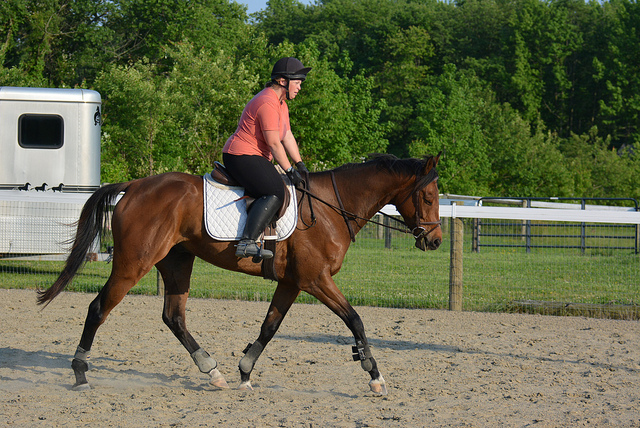Jessica Morthole deftly balances to steady the powerful racehorse as he tosses his head and dances out of rhythm. Posting above Gib’s irregular gait, she maintains gentle contact with her hands, when, in a sudden burst of passion, he twists his body away from her contact, and explodes.
Thinking with the calm purpose of a test pilot, Morthole squares her shoulders, drives her heels low, sits deeper in the saddle and pulls the spooked animal back to reality, settling him down again for another try at trotting correctly.
This is a woman well seasoned in the uncommon art of retraining Thoroughbred racehorses.
And what may look to the casual observer as nothing more than a woman riding a squirrely horse is so much more. Gib is a retired racehorse in a world where horses can easily slip through the cracks, landing at kill pens and slaughterhouses.
Whether that would have been Gib’s lot or not, one can’t say, but Morthole spends her time testing and re-training ex-racehorses for CANTER Mid Atlantic, and doing the brave work for the Thoroughbreds she loves.
A normal day at the office finds her sitting atop these unpredictable creatures through spooks, bucks and spins until, in the end, a levelheaded and marketable horse emerges.
“My family has been involved in racing and I grew up riding and retraining racehorses,” Morthole says. “I don’t have any huge credentials; I just specialize in retraining OTTBs.”
Her ongoing effort to make Gib into an honest citizen will be documented in the latest Trainer Challenge spearheaded by pioneering racehorse trainer Steuart Pittman. Morthole is among 26 trainers participating in the Retired Racehorse Training Project’s Thoroughbred Makeover event.
The challenge is to present a once-green OTTBs, now trained with foundational work, at a national symposium at Pimlico on Oct. 5 and 6. The event is part of an ongoing effort to prove the worth of Thoroughbreds in the sport-horse world, and is one of several successful ventures put forth by Pittman.
After winning a spot among the 26 trainers in the Thoroughbred Makeover, Morthole immediately thought of Gib, who first glowed with robust health, and later shrank in the post-racing letdown.
“When I first got Gib from Delaware Park, he was beautiful. But after I got him, I turned him out for 10 months in a field with other horses, and he went through The Big Crash.”
He lost weight after going from a high-octane diet and constant stabling to a free-range life with grass growing up to his knees and 14 other horses to run around with.
“It took him a long time to get comfortable, and he lost weight,” she says.
But by the seventh month, he started shaping up and looking good again. And then he told her he was ready to go back to work.
“People ask us all the time at CANTER Mid Atlantic how we know when a horse is ready to start work again. And, Allie Conrad, the director, and I, always say the same thing. We say, ‘We walk out into the field and if they walk up to us and say, ‘What are you doing?’ we know they’re ready,” Morthole says. “The ones who approach you kind of tell you in their own way that they’re ready.”
When she first started retraining Gib, he seemed easy. He clearly wanted a job, but when asked to rebuild muscles that had gone soft during his days of leisurely grass eating, he got a bit testy.
“He’s definitely going through some growing pains,” she adds.
The key for Morthole is to work Gib through his moments of “freshness” and keep his mind engaged with learning. She believes that Gib can be a truly great mount for a high-level equestrian.
“A lot of people who see him would want this horse. He’s big and beautiful and he has a really big movement. Everybody would want him, but he’s not a horse for everybody,” she says. “This is why re-training is so important. It gives us an insight into the horse, and ensures that when we do place him, he’ll go to a confident rider.”
Noting with some pride that CANTER was one of the first nonprofit horse charities to re-train its horses before selling them, Morthole says the importance of training, as will be showcased in the upcoming Thoroughbred Makeover, cannot be emphasized enough.
“Good training pretty much guarantees that you’re going to get them in the right home the first time,” she says.
To follow Morthole’s progress with Gib, please check out her blog entries on Retired Racehorse Training Project.






Our OTTB going through the same thing. She was rescued from slaughter and is now with a natural horsewoman. We are doing groundwork. We have patience with our smart and sensible girl. We are learning with her. She learns faster than we do, but it’s a balancing act and it seems to be working. Not sure what her next job will be, but she is alive, well, healthy and happy. And, yes, she went from a fancy heated barn in PA to a run-in shed in the Adirondacks this past winter. She is now down here in CT (nearby, finally, yay!) with free roaming and a stall to comfort her should she want that. Learning to be a horse!